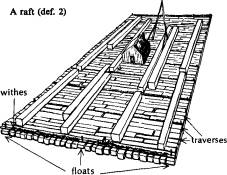Quick links
raft ((n.))
DCHP-1 (pre-1967)
Entry from the DCHP-1 (pre-1967)
This entry may contain outdated or offensive information, terms, and examples.
1†n. — Lumbering
a number of pieces of timber pinned, bound, or otherwise kept together to facilitate transport by water.
Quotations
1697
[two of ym brought their rafts wth ym[;] ye other came aground.]
1790
I git a Raft of plank boards &c., from the falls, & have the Clapboard, that were Counted yesterday, Spread to dry.
1829
. . . some squatters have made clearings and settled, for making rafts.
1849
The process is to break up the raft and commit the spars to the stream. About an hour after that perhaps two or three sticks reach Peterborough, the rest are left sticking here and there on rocks, dams and islands.
1892
The logs are generally [B.C. coast] brought from the places where they are cut ("logging camps") to the shore on "skid-ways," after which they are formed into rafts and these are towed to the various mills.
1965
The process of getting the logs off the snags and sandbars and of marshalling them into rafts involved the now almost forgotten art of "birling," wherein the rivermen, pikes or peavies in hand, worked logs out of shallows by spinning them under their sure feet.
2n. — Lumbering, Hist.
a large assemblage of square timbers, spars, etc. arranged in any of several ways according to the conditions of the waterways used.
Such rafts, of varying construction, were for more than a century a common sight moving toward Quebec on the Great Lakes and the St. Lawrence River and its tributaries, especially the Ottawa. No attempt has been made here to distinguish the differing types of rafts, although the quotations touch on the subject.
Quotations
1796
I walked to the Seigneurie House [and] examined a raft lying in the Chateauguay River and thought its construction very curious.
1807
The rafts of oak timber and staves are of a different form.
1846
A raft a quarter of a mile long . . . is curious enough; but to see it in drams, or detached portions, sent down . . . the timber slides of the Ottawa . . . is still more so.
1864
To understand how the thing works, you must know that a "raft" consists of 30 or 40 separate "cribs," that is, subdivisions or small rafts, each crib complete in itself, and all bound together by cords and withes.
1945
. . . an average [St. Lawrence River] raft of the 1870's might contain twelve to sixteen drams--occasionally more.
1961
The last raft of timber went down the mighty Ottawa in 1909.
1963
The last raft of square timber went down the St. Lawrence [from the Lower Lakes], running the rapids, in 1911.
1964
The raft was a great floating community of up to 250 lumberjacks. At one end would be the cook's shanty with its fireplace built on sand and ashes.
3n.
of ice, an ice formation resulting from large cakes of ice being lifted by pressure on top of other ice.
See: raft ((v.))(def. 3)
Quotations
1944
. . . the ice was a mass of hummocks with rafts over twenty feet in height.
1964
Now in November it [the river] was nearly choked ; a mad race of water in the middle flung rafts of ice to the sides, burrowed under ice bridges, and showed in roils and slicks as far as could be seen. Soon a man could drive right across.
Images
